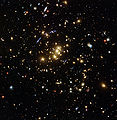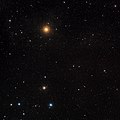Datei:CL0024+17opt.jpg

Grate faan detdiar föörskaubil: 586 × 600 pixel. Ööder apliasangen: 234 × 240 pixel | 469 × 480 pixel | 750 × 768 pixel | 1.001 × 1.024 pixel | 2.001 × 2.048 pixel | 3.838 × 3.928 pixel.
Originaal datei (3.838 × 3.928 pixels, dateigrate: 18,67 MB, MIME-typ: image/jpeg)
Datei wersioonen
Klike üüb en tidjponkt, am detdiar wersion uuntulukin.
| Dootem/Tidj | Föörskaubil | Miaten | Brüker | Komentaar | |
|---|---|---|---|---|---|
| aktuel | 17:01, 19. Jul. 2009 |  | 3.838 × 3.928 (18,67 MB) | Tryphon | Original size. |
| 04:10, 17. Mei 2007 |  | 1.251 × 1.280 (1,97 MB) | Clh288~commonswiki | {{Information |Description=This rich galaxy cluster, catalogued as Cl 0024+17, is allowing astronomers to probe the distribution of dark matter in space. The blue streaks near the center of the image are the smeared images of very distant galaxies that ar |
Hü det datei brükt woort
Detdiar sidj brükt detdiar datei:
Globaal brük faan datein
Jodiar ööder Wikis brük detdiar datei:
- Brük üüb ar.wikipedia.org
- Brük üüb en.wikipedia.org
- Brük üüb en.wiktionary.org
- Brük üüb hu.wikipedia.org
- Brük üüb it.wikipedia.org
- Brük üüb ko.wikipedia.org
- Brük üüb nl.wikipedia.org
- Brük üüb nl.wikibooks.org
- Brük üüb pl.wikipedia.org
- Brük üüb pl.wiktionary.org
- Brük üüb tr.wikipedia.org
- Brük üüb www.wikidata.org
- Brük üüb zh.wikipedia.org


